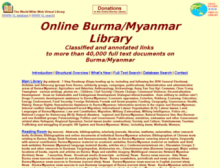Resource information
INTRODUCTION: "The November 8, 2015 elections in Myanmar
marked a historic milestone in the country’s political
and economic transition that began in 2011.
Incoming policy makers are preparing to pick up the
baton and deliver on the people’s strong aspirations for
a harmonious and prosperous Myanmar. In this series
of policy notes, the World Bank Group seeks to promote
dialogue on critical development challenges and
on options for policies and reforms that can contribute
to shared prosperity for the people of Myanmar.
Myanmar has strong medium-term growth potential.
Efforts to open up and liberalize the economy over the
past 4 years have revealed pent up demand, brought
in new investments, and increased productivity from
a very low base. Between 2011 and 2014 Myanmar’s
economy grew at an average real rate of 7 percent per
year, which is among the fastest in East Asia, and comparable
to other high performing countries in their initial
phase of liberalization. In the coming years, further
removal of economic controls could help Myanmar to
maintain a strong pace of growth.
Myanmar has a real opportunity in ensuring
that growth is also inclusive. This not only means
sustaining a strong pace of growth, but doing so
through a diversified economy that can absorb the
labor force into higher productivity sectors. The
agriculture sector, which suffers from low productivity,
contributing on average only 10-15 percent to annual
real GDP growth over the past 4 years, employs over
half of the country’s labor force. The manufacturing and
construction sectors on the other hand, which have
the highest value added per unit of labor, employ only
10-15 percent of the labor force.
Policies that can enable a structural shift to more
productive and labor intensive activities could make
a big dent on poverty and inequality in Myanmar.
These would include expanding access to essential
public services. This could enable a bigger share of
the population to benefit from the agglomeration of
economic activities around Myanmar’s growth poles,
namely Yangon and Mandalay, which account for
roughly 35 percent of national GDP.
The sound governance and use of Myanmar’s natural
resource wealth are also critical to inclusive
growth. Around 10 percent of Myanmar’s official GDP
is derived from natural resources, though some estimate
unofficial trade in natural resources at more than
20 percent of official GDP. This not only concentrates
wealth from non-renewable national assets in the hands
of a few, but also finances conflicts, which have created
vicious cycles of poverty that are geographically and
ethnically concentrated.
Policy reforms since 2011 have started to promote
inclusion so that a growing share of Myanmar’s
people can take advantage of new opportunities
and benefit from economic growth. Higher tax collections
from non-agriculture sectors and rising natural
resource rents have enabled Myanmar to reprioritize
public spending towards critical economic and social
service needs. Foreign exchange, trade and investment
liberalization have opened up economic opportunities
and the space for investment beyond a small group of
highly protected sectors. Increased public sector transparency
and decentralization have started to gradually
bring the state closer to the people.
Given this context, how can Myanmar advance
reforms to close the disparities across its geography,
ethnic communities, and income groups; and to
promote productivity and competitiveness? This is
the question that this series of policy notes, “All aboard!
Policies for shared prosperity in Myanmar,” aims to
generate debate and ideas. The theme “All aboard” is
meant to reflect inclusivity and imminent departure on
a positive journey.
The policy notes focus on six interconnected areas
that are likely to be high priorities for shared prosperity
(figure 1). The first is on closing the gap in access
to social services for improving Myanmar’s human
development outcomes. This could help to strengthen
the productivity and employability of Myanmar’s current
and future labor force, which is the critical input to
inclusive growth and a precondition to success in all
the other areas. The second policy note is on growing
together by reducing poverty in rural areas. Policies
to boost agriculture productivity and accelerate the
delivery of essential services in rural areas, where they
lag the most, could help to supply the much needed
labor and food for the rapidly expanding industrial,
manufacturing and service sectors.
Investment in higher productivity sectors is also likely
to require breaking business as usual to foster competitiveness
and a dynamic environment for private
sector growth across the country, which are discussed
in the third policy note. These include policies that are
targeted at reducing the costs of doing business and
engaging in international trade. The relative impact
of these could be enormous in terms of incentivizing
private sector investments, expanding access to economic
opportunities for rural and urban populations,
and diversifying the sources of growth.
Enabling these to drive major structural transformations
in the economy is likely to require policy reforms in two
important areas. The fourth policy note therefore looks
at options to expand Myanmar’s ability for financing the
future through an open, modern, and inclusive financial
system. This is important not only for channeling savings
to large private investments, but also to finance public
sector operations and service delivery, facilitate the
expansion of international trade, and enable the transfer
of increased remittances to rural areas. The fifth policy
note is on energizing Myanmar by enhancing access to
sustainable energy for all. Myanmar’s growing economy
will need more energy than is currently supplied – not
only for productive sectors, but also for the delivery of
public services across the country.



